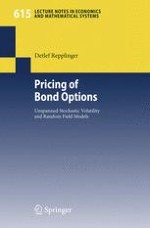2008 | OriginalPaper | Buchkapitel
Multiple-Random Fields term structure models
Erschienen in: Pricing of Bond Options
Verlag: Springer Berlin Heidelberg
Aktivieren Sie unsere intelligente Suche, um passende Fachinhalte oder Patente zu finden.
Wählen Sie Textabschnitte aus um mit Künstlicher Intelligenz passenden Patente zu finden. powered by
Markieren Sie Textabschnitte, um KI-gestützt weitere passende Inhalte zu finden. powered by
The first generation of term structure models started with a finite factor modeling of the process dynamics with constant coefficients (e.g. Vasicek [73], Brennan and Schwartz [10], Cox, Ingersoll, and Ross [22]). Due to the fact that this type of models are inconsistent with the current term structure, the second generation of models exhibits time dependent coefficients (e.g. Hull and White [41]). A completely different approach starts from the direct modeling of the forward rate dynamics, by using the initial term structure as an input (e.g. Ho, and Lee [39], Heath, Jarrow, and Morton [35]).
One drawback of this kind of models comes from the need of a permanent re-calibration over time in order to fit the model to every new term structure. To overcome these restrictions, Random Field (RF) models offer an appealing alternative to extend the traditional type of term structure models. Random Field models were first introduced to the finance community by Kennedy [50] and [51]. Kennedy [50] derives the dynamics of the forward rates by assuming Gaussian Random Fields and precluding arbitrage opportunities equivalent to HJM [35]. By contrast, the traditional type models, where the entire term structure is driven by multiple Brownian motions, the RF models are driven by an infinite number of sources of uncertainty. Each of the continuously defined forward rates is linked to a different kind of dynamics driving the innovation. Therefore, these models are also called infinite factor models. This type of innovation allows a new framework that incorporates the circumvention of the limitation to finite-dimensional factor models, without losing the affine structure of the traditional type models (Collin-Dufresne and Goldstein [18]).
